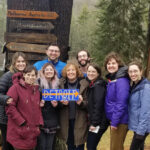Dear Friends,
At a conference last year, I got to visit Ohio State’s (I know: like Haman, boo!), Byrd Polar and Climate Research Center. There, I heard from a lovely couple who had been working in the basement of the facility for decades, gathering ice core samples from around the globe and bringing them back to Columbus for research purposes. Traveling to far off places where ice is rapidly melting, they and their team drill down into ice sheets, extract multi-foot long, narrow cylinders of ice known as “cores,” and then transport that sample back to their labs for testing. By examining the contents of the ice they collect, they can draw a wide range of climate-related conclusions. It is as if they are developing film of sociological phenomena, their lab like a “dark room” where pictures of history, embedded in these artic time capsules, come into focus.
Perhaps the most interesting finding for a Motor City newcomer like me, was when they described how they could tell precisely when the auto industry began in Detroit by looking at ice core samples from Greenland throughout the 1900s. How so? As Detroit factories and the Industrial Revolution boomed here locally, wind and weather patterns carried the output of industry – pollution, toxins, particles, and the like – through the air, across the Atlantic, and over the skies of Greenland, where the ice inhaled and captured the refuse of the Big 3. They could see clear as day, captured in the tall cylinders of ice, how activity in one place impacted the health and wellbeing of another.
Now, as Coronavirus has arrived in Michigan, we are reminded again just how enmeshed our lives are with the lives of those around us. At this point, many of us likely know someone who knows someone who has been exposed. Or perhaps it’s already more personal than that. Surely, our clothes, our devices, our accessories are made up of parts that have been mined or sewn or printed or shipped from any number of countries many thousands of miles away. And we are glued to those same devices, as they stream and we consume news and video and footage that give us fingertip glimpses into the day-to-day lives of those so far away and the breaking news right around the corner.
This interconnectedness can be scary, of course, as we’re experiencing right now. Yet, it also points to the foundational solution to our biggest problems, including the overarching challenges of climate. Just two days ago, we celebrated the holiday of Purim, a story in which, famously, God’s name is never mentioned. Instead, we see a narrative unfolding that centers the interconnectedness of humans and the overturning of expectations. Mordechai sees himself as part of a human family, and so won’t bow to Haman. Mordechai leverages his relationship with Esther to encourage her to confront the King. Esther recognizes her place within the Palace and the role she can serve for the Jewish people and shrewdly intercedes with the King on behalf of the Jews. One thing leads to another. One conversation sparks the next. One action sets off a chain reaction. And the story ends with the Jews victorious, avoiding genocide, the world turned rightside up. What at first seems separate is actually inseparable.
Is it not this false precept of separation, of strict independence, that got us into this climate reality in the first place? Thinking that our actions impact only us. That the fires happening down there, or the floods happening over there, or the glaciers melting up there don’t impact us, because we can’t yet smell the smoke, or see the water, or hear the calving. It’s the harmful assumption that the natural world is merely an object, to which we can do as we please, that has led to the spiraling situation we’re in today. And it’s the inverted relational kind of thinking that Purim has come to remind us – “v’nahafoch hu,” everything is topsy-turvy, everything is connected – that just might set us free.
As we brace for and respond to the real and growing threat of Coronavirus, alongside the ongoing threat of our devolving climate, may we embrace an ethic of interconnectedness as an approach to mitigate the negative effects of both. Our community’s health requires a heightened awareness that touching, that sharing space, and personal hygiene impact more than just us. That in a connected world, like the ice cores reveal, our actions do indeed have an impact on those around us. It also demands, precisely because our actions have an impact on each other, that we care for one another, deeply, starting with those who have the least and are the most at risk. And it calls us to collaborate and work together to find a long-lasting solution to both this immediate health threat, and this long-lasting climate threat. God willing, the health-related challenges of these times will be resolved quickly, and we then might apply the same lessons of interconnection, of collaboration, and of urgency to the world around us.
In this month’s newsletter, we are raising up that practice of partnership, affirming that our strength is greater together. In this light, we’ve just completed three major projects that highlight our role as committed community partners, helping five organizations “green” their Purim celebrations for over 2,000 attendees, sending representatives from five organizations on a nature immersion in Connecticut, and working with eight organizations to distribute over 1,800 reusable produce bags throughout the community. Together, may we reaffirm all the ways we impact each other and the world, and may we embrace the power of connection, safely and for good.
In loving community,
Rabbi Nate, Wren, Marla, Brittany, and Hannah
